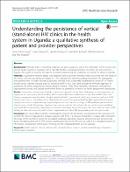Understanding the persistence of vertical (stand-alone) HIV clinics in the health system in Uganda: a qualitative synthesis of patient and provider perspectives

View/
Date
2018-09-05Author
Zakumumpa, Henry
Rujumba, Joseph
Kwiringira, Japheth
Kiplagat, Jepchirchir
Namulema, Edith
Muganzi, Alex
Metadata
Show full item recordAbstract
Although there is mounting evidence and policy guidance urging the integration of HIV services into
general health systems in countries with a high HIV burden, vertical (stand-alone) HIV clinics are still common in
Uganda. We sought to describe the specific contexts underpinning the endurance of vertical HIV clinics in Uganda.
Methods: A qualitative research design was adopted. Semi-structured interviews were conducted with the heads of
HIV clinics, clinicians and facility in-charges (n = 78), coupled with eight focus group discussions (64 participants)
with patients from 16 health facilities purposively selected, from a nationally-representative sample of 195 health
facilities across Uganda, because they run stand-alone HIV clinics. Data were analyzed by thematic approach as
guided by the theory proposed by Shediac-Rizkallah & Bone (1998) which identifies; Intervention characteristics,
organizational context, and broader environment factors as potentially influential on health programme sustainability.
Results: Intervention characteristics: Provider stigma was reported to have been widespread in the integrated care
experience of participating health facilities which necessitated the establishment of stand-alone HIV clinics. HIV
disease management was described as highly specialized which necessitated a dedicated workforce and vertical HIV
infrastructure such as counselling rooms. Organizational context: Participating health facilities reported health-system
capacity constraints in implementing integrated systems of care due to a shortage of ART-proficient personnel and
physical space, a lack of laboratory capacity to concurrently conduct HIV and non-HIV tests and increased workloads
associated with implementing integrated care. Broader environment factors: Escalating HIV client loads and external HIV
funding architectures were perceived to have perpetuated verticalized HIV programming over the past decade.
Conclusion: Our study offers in-depth, contextualized insights into the factors contributing to the endurance of
vertical HIV clinics in Uganda. Our analysis suggests that there is a complex interaction in supply-side constraints
(shortage of ART-proficient personnel, increased workloads, laboratory capacity deficiencies) and demand-side
factors (escalating demand for HIV services, psychosocial barriers to HIV care) as well as the specialized nature of
HIV disease management which pose challenges to the integrated-health services agenda.
URI
https://doi.org/10.1186/s12913-018-3500-4https://kyuspace.kyu.ac.ug/xmlui/handle/20.500.12504/323
